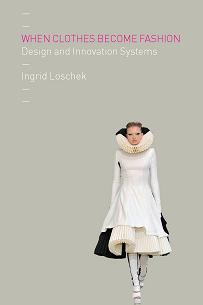Prof.
Dr. Ingrid Loschek
Theory and History of Fashion
* 9.2.1950 Vienna † 5.3.2010 Munich
Konrad-Dreher-Str. 4380689 Munich/Germany
Tel. + 49 89 7000 90 36
Fax + 49 89 7000 90 37
Email: w.loschek@yahoo.de
Ingrid Loschek has held a professorship of history and theory of fashion at the University Pforzheim, School of Design, Germany. 1995/96 she has been a visiting scholar at Harvard University, Cambridge, USA and 2004 a guest-professor at the Japan Women’s University in Tokyo, Japan, in connection with a research on Women's Emancipation from 1850s to 1990s communicated by Fashion. In 2004 she was in charge of a Fashion-Workshop in Hanoi und Saigon on the occasion of the „Performing Art Festival“ of the ASEM V summit conference. In 2005 she gave lectures as guest professor at the Helwan University in Cairo and in El-Mansura, Egypt (see lectures).
Ingrid Loschek was one of the most well-known fashion-experts in Germany with a wide range of research. Among her interdisciplinary researches are the Sociology and Behaviourism as Background of Fashion as well as Women’s Emancipation communicated by Fashion.
She has written a number of publications, such as: When Clothes Become Fashion. Design and Innovation Systems (engl., Berg Publishers 2009); Mode-Designer (Beck 32007); Fashion of the Century. Chronik der Mode von 1900 bis heute (Battenberg 2001); Reclams Mode- und Kostümlexikon (Reclam 52005); Mode - Verführung und Notwendigkeit (Bruckmann 1991) as well as many articles and features.
She talked widely on subjects like Fashion and Post-Modernism, Fashion and Art, Fashion and Politics, The Meaning of Accessories and Art Deco and the 'New Woman' in the German Metropolis Berlin (see speeches).
Ingrid Loschek studied in Vienna (Austria) and in Manchester (GB) Drama, History of Arts and Costumes and graduated at the University of Vienna. Her fashion archive in Munich holds over 3000 fashion-magazines from the 19th to the 21st century as well as historical photographs. In 1998 she received the Europäische Mode-Initiativpreis der Kultur-Fördergemeinschaft der Europäischen Wirtschaft. She was chairwoman of the Ruth-Bleckwenn-Stiftung, member of the ICOM Costume Committee and the netzwerk mode textil e.V. (Network of Fashion and Textile).
Among her major Publications are:
 When
Clothes Become Fashion. Design and Innovation Systems (engl.), 224 p., 24 ill.
When
Clothes Become Fashion. Design and Innovation Systems (engl.), 224 p., 24 ill.
Oxford-New York: Berg Publishers 2009. ISBN 978 1 84788 366 7
Wann ist Mode? Strukturen, Strategien und Innovationen. 274 p., 22 ill., Berlin: Reimer, 2007. ISBN 978-3-496-01374-7
Mode-Designer. Ein Lexikon von Armani bis Yamamoto. (Fashion-Designer. An Encyclopedia from Armani to Yamamoto). 239 Seiten, 80 Abb. München: Beck, 32007. ISBN 978-3-406-56492-5
Reclams Mode- und Kostümlexikon. (Reclam’s Encyclopedia of Fashion and Costume). 640 p., 513 ill. Stuttgart: Reclam, 52005. ISBN 3-150-10577-3
Fashion of the Century. Chronik der Mode von 1900 bis heute. (A Chronicle of Fashion from 1900 until today). München: Battenberg, 2001. ISBN 3-89441-441-3
Mode im 20. Jahrhundert. Eine Kulturgeschichte unserer Zeit. (Fashion of the 20th Century. A Cultural History of today). München: Bruckmann, 51995.
Accessoires. Symbolik und Geschichte. (Accessories. Symbols and History). München: Bruckmann, 1993.
Mode - Verführung und Notwendigkeit. Struktur und Strategie der Aussehensveränderungen. (Fashion – Temptation and Necessity. Structures and Strategies of Human Images). München: Bruckmann, 1991.
Beate Schmid /
Ingrid Loschek (Hrsg.)
Klassiker der Mode. Die Erfolgsgeschichte legendärer Kleidungsstücke und
Accessoires. (Classics in Fashion). Augsburg: Battenberg, 1999. ISBN
3-89441-380-8
Max von Boehn,
bearb. Ingrid Loschek.
Die Mode. Eine Kulturgeschichte vom Mittelalter bis zum Jugendstil. (Fashion. A Cultural History from Middle
Ages to Art Nouveau). 2 Bde.
München: Bruckmann, 51996.
Authentisch kopiert – Mode aus dem 20. Jahrhundert. (with English summary) (Authentics or Copies – Fashion of 20th Century). In: Zeitschrift der Gesellschaft für Historische Waffen- und Kostümkunde, 1/2003. ISSN 0042-9945
Mode und Architektur in der zweiten Hälfte des 20. Jahrhunderts - Ein stilistischer Vergleich. (with English summary) (Fashion and Architecture in the 2nd half of the 20th Century.) In: Zeitschrift der Gesellschaft für Historische Waffen- und Kostümkunde, 1/1998. ISSN 0042-9945
Internet Articles
Used all over the World – Mannequins Made by Cologne-Based Company Moch, Goethe Institute. July 2009.
The Tried-and-True Between Tradition and Innovation: Fashion Magazines in Germany. Goethe Institute. March 2009.
Prized Dresses Made from Worthless Materials – the Fascination of Stephan Hann’s Creations. Goethe Institute. December 2008.
The Charm of Knirps and Birkenstocks. Goethe Institute. September 2008.
Fashion in Germany – Between Avant-Garde and Ready-to-Wear Clothing. Goethe Institute. June 2008.
Elegant, Individual, Eccentric, Creative – Men’s Fashion from Germany. Goethe Institute. April 2008.
Fashion under the microscope. Goethe Institute. March 2008.
Gabriele Strehle – Fashion Designer. Goethte Institute. October 2007.
Innovation and Diversity: Munich – a Focal Point for Fashion. Goethe Institute. September 2007.
Versatile and Political – Eva Gronbach and Her Collections. Goethe-Institute, October 2006.
Little Red Riding Hood Meets Superman – Bernhard Willhlem’s Creations. Goethe Institute. April 2006.
From Sportswear to Sports Couture. Goethe Institute. July 2005.
Not Just for the Oktoberfest – Tracht is Trendy. Goethe Institute. June 2005.
